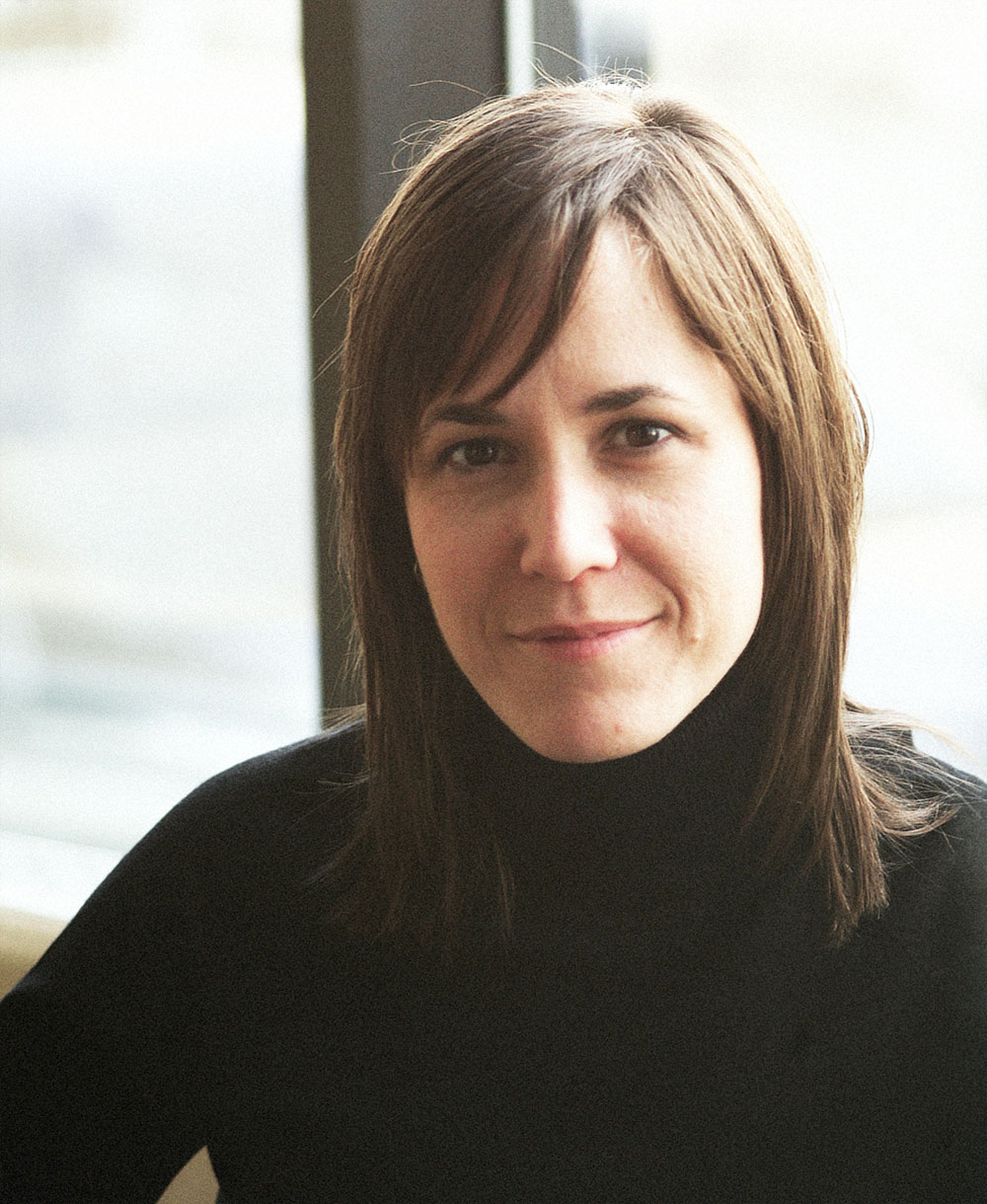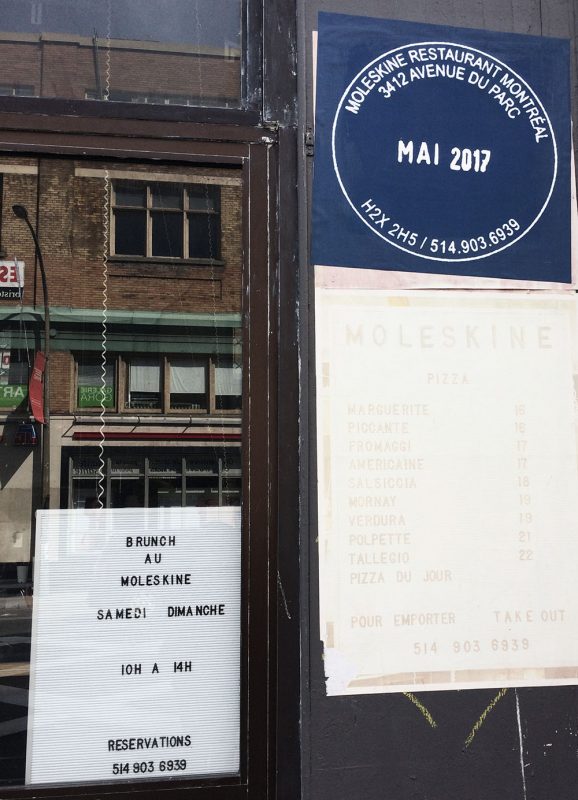Véronique Dalle, Sommelier, Moleskine in Montreal, QC: Mav Chefs 2017

Every year, Quench profiles Canadian chefs who are contributing that elusive something to the food scene, helping to change it, helping it to evolve. This year’s lineup is (often unintentionally) helping to define Canadian cuisine, which is no mean feat. A love of wine and all things beverage has seeped into the Canadian consciousness — finding a restaurant with exquisite food AND a great beverage menu isn’t as hard as it once was. That’s why, this year, we’re including our first Mav Sommelier.
Véronique Dalle is the co-owner of Moleskine, a three-part restaurant that offers takeout (through the street-level walk-up window), a pizzeria on the first floor and a 30-seat fine dining restaurant on the second floor. Dalle’s goal, in partnership with her co-owners — chef Frédéric St-Aubin, Bruno Braën and Catherine Bélanger (the latter two are also owners of neighbouring restaurant, Pullman) — is to make wine more approachable to everyone. It’s not about haute cuisine and crazy-expensive bottles. Instead, wine, beer and cocktails are acceptable alternatives to soft drinks for pairing with your pizza.
Why did you become a sommelier?
My first career is classical music. I studied at [the] Conservatoire, I went to university. I was playing freelance oboe for the Metropolitan Orchestra and a few other orchestras around [Montreal]. I paid [my way] through school working in restaurants. After a while, I took a sommelier class at the ITHQ [Institut de tourisme et d’hôtellerie du Québec] because I just wanted to do more than just being a waitress while I paid [my way] through school. My music practice was like eight hours a day. So, for me, to study wine was fun. I had a break. I could talk about something completely different that touched history, geography, geology — and everything was so fun, it was another form of expression.
I was able to go study in France. When I came back, I was still a professional musician working freelance, but the ITHQ called me and proposed to me a teaching position. I had to make a choice …. And Pullman asked me if I was interested to join the team. So, it just happened by itself. It was easy because everything was so fun. Tasting was fun. Studying all the history around the wine was fun. All the new people that I met were very passionate.
Were there any major obstacles or hurdles that you had to overcome?
Oh no, the path was just open to me. I was very lucky because I had a very good teacher at the beginning and I had a very good music teacher who taught me very good values [of] being autonomous with taking charge of my own path. You have to have your own values and the right opportunity will show up to you. I didn’t have so many obstacles because what I was looking for was very clear to me.
Is it difficult to you chase your own values and ensure your values are represented in your establishment?
It’s kind of a dance, really. Being a sommelier is one thing; it’s a whole set of expertise. Being a restaurateur and owner taking charge of everything and a team, and being a good leader — inspiring, but clear — you don’t need to be firm, you need to be clear in what the restaurant values are so people can just follow in your steps. It takes a lot of work. It’s really a tango between your message, your team and the guests. That’s what’s interesting. That’s why I’ve been doing this for many years, because “Oh, I didn’t think of this” and “the reaction of this customer makes me think I can do this better or change this.” It’s always good to hear how people live the experience that you’re trying to create and you realize that sometimes what you had in mind isn’t what comes through.
Speaking of your team at Moleskine, what role do they play in how you work with the wine suggestions and how that all comes together?
I have a team; we’re three sommeliers on the floor. I’m very lucky. I work with one of the best in the world, Alain Belanger, who was the third runner-up of the Mondial competition a few years back. He just wants to do one night with me, so I work with him and I work with Nadine, who also does one night. And the rest of the sommellerie I do it myself, with Fred who is the chef. So, Fred is my partner, and he is very creative. He has a very good palate and we have a very similar palate.
I don’t want to use farm-to-table, but we do [a] very pure, clean style of cooking. So, it’s very easy for the wine pairings. We usually do a food tasting; we talk about a few dishes. We do a first tryout to see how it turns out and we adjust. We do a real tasting with the team, and then I just take out some wines and I order wines according to what I’ve tasted. But it’s a very free process. There’s nothing too intellectual about it; it’s just fun. And I have the [opportunity] of working with Fred … he can adjust any dishes to a wine. It’s a collaboration.
What makes a good sommelier?
I think to be a good sommelier, you need to have a very good technical knowledge, you need to be a very good taster, you need to have a very good knowledge of the kitchen preparations —the type of fats that are used in cooking will change the texture of tannins — the different cuts of meat. You need to know so many things and to be interested in such a wide variety of things to make your proposition interesting or coherent with what they’re having. After that, if your guest doesn’t want what you propose, you need to be able to get him to listen, to get him the closest to what he wants with being as close [to] what the dish will allow. I think to be a good sommelier, you definitely need to listen to the guest first; I think it’s the main thing. And all the old-school sommeliers will say the same thing. After that, the guest is there to have fun. If he wants a Red Bull vodka with his tuna, well, so be it. What can you do?

So then, when you’re recommending a wine, your end goal is to provide them with an enjoyable experience?
My end goal is to provide them with an enjoyable experience. But my motivation is a bit larger than that. I need to respect the producer, because I’m just an intermediary between the producer and customer. So, I need to propose a product and treat it as it should [be treated]: the right temperature, the right glass, to make its presentation the best, to optimize the tasting of the wine. And through that, I have. It may be a little bit pretentious of me, because I have a lot of repeats, [but] I see where [my guests] start, and I want them to travel further. So, if they don’t, I’m not going to force them. I think that’s why I have customers that follow me for so long. Since the beginning of my career … my first job out of school, I still have guests that follow me until now. It’s been 20 years. They tell me “remember when you got me … you made me taste this wine that came from Serbia … you made it [a] blind taste because I told you ‘no’ and you brought it to the bar and told me, ‘I just opened this, taste that” and oh my god, it’s so extraordinary.” For me, it’s always a bit of fun. I know I’m a bit direct and sometimes a bit cocky, but it’s always from a good place, you know. And, people, they enjoy it.
Your goal with Moleskine, is it wine-based or food-based, or a combination of the two?
At the beginning, it was not wine-oriented project. Downstairs is mostly a pizzeria, and we have a collaboration with organic wine producers from France, friends of mine who don’t do bulk wine at all. Like Mathieu Lapierre, a really well-known Morgon producer, sold me 600 litres because I wanted to give students easy access to wine, for them not to drink Coca-Cola, but for them to drink a good glass of Beaujolais with their pizza. For me, it was my goal, still teaching. Still going towards demystifying that good wine is for everyone, it doesn’t need to cost you an arm and a leg. It’s so much fun just to have a good glass of wine with a pizza; it’s simple, good, efficient. Since I have no sommelier downstairs, and I have no place for recycling, we decided to do wine on tap. And for upstairs, we have a short wine list that changes every week, so I would like it to be a little bit more wine-oriented, because this is who I am.
Moleskine was mostly a restaurant that we wanted to open that was with no boundaries. We are just starting, so we have a small wine program, but I do so much research. It’s as exciting, or more exciting, to do a smaller version of a wine list than a huge wine list where I have 400 entries. I have a handful of reds and whites, but I know everything I offer is good. Very good. For me, it’s as interesting as doing a big wine program where half of the wines sleep in the wine cellar. I get to taste all these wines that I have on the wine list at least every week. Even the wines that are more expensive. It’s a different experience, but it still fulfills my wine needs as a sommelier. When you have a small wine list, every wine that you pick is like a jewel. And you say, ‘oh my god, they’re going to find this wine amazing.’ And I put this on the wine list and all of the team are excited about it. The energy is completely different when you have limited access.
What’s your favourite wine right now?
I can tell you I already sold all of it this year. It’s a producer that, year after year, I love to get his wines. The producer’s name is Richard Leroy, he’s from Anjou, France. He produces a white Chenin that’s called Le Clos des Rouliers. He does two cuvées, but on vintage 2014, which was this year’s, he does a top cuvée, which was Noëls de Montbenault. This tasted … wow. So much energy in the wine. Beautiful, beautiful Chenin Blanc. There are some tastings that touch you and they make you feel “wow, this is extraordinary” and “I’m so lucky to taste this.” One grape variety. One vintage. No blend, no nothing. Just the expression of one space from one place in the world, by one person who work at that spot. It was a remarkable wine.
This wine was one of the top of the year for me. I couldn’t say in my career what I preferred, because I love Burgundy, but this was remarkable.
Wine Pairings
I asked Dalle to suggest which wines would pair well with the recipes our Mav Chefs provided this year. Here’s what she said:
Roasted Cauliflower with Radish Top Pesto by Dan Vorstermans from The Highwayman in Halifax, NS
Viña Tandonia Rioja Reserva Blanca 1998, López de Heredia, Spain
Rabbit Cacciatore with Pine Mushrooms by Mark Perrier from Osteria Savio Volpe in Vancouver, BC
Domaine du Collier Saumur Champigny 2005, La Ripaille, France
Ricotta Cavatelli with Venison Ragu by Michael Hunter from Antler Kitchen Bar in Toronto, ON
Bartolo Marscarello Barolo 2008, Italy
Domaine Labet Côtes-du-Jura 2014, Les Varrons, France
